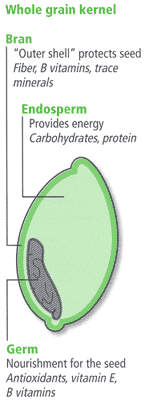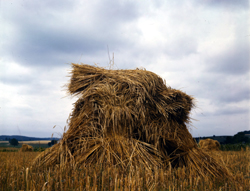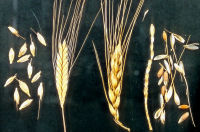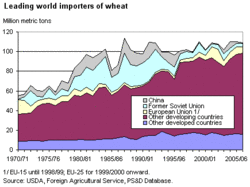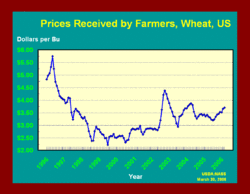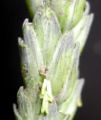Wheat
 From Citizendium - Reading time: 15 min
From Citizendium - Reading time: 15 min
| Wheat | ||||||||||||||||
|---|---|---|---|---|---|---|---|---|---|---|---|---|---|---|---|---|
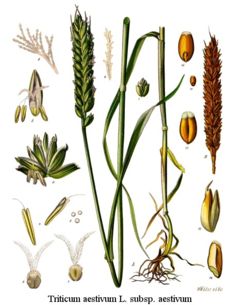 Common wheat, Triticum aestivum L.
| ||||||||||||||||
| Scientific classification | ||||||||||||||||
| ||||||||||||||||
| Species | ||||||||||||||||
|
T. aestivum |
Wheat (various species of the genus Triticum) is a grass with so many important uses that it is cultivated worldwide. Not only is wheat an important crop today, it may well have influenced human history. Wheat was a key factor enabling the emergence of city-based societies at the start of civilization because it was one of the first crops that could be easily cultivated on a large scale, and had the additional advantage of yielding a harvest that provides long-term storage of food.
Globally, wheat is the leading source of vegetable protein in human food, having a higher protein content than either maize (corn) or rice, the other major cereals. In terms of total production tonnages used for food, it is currently second to rice as the main human food crop, and ahead of maize (corn), after allowing for maize's more extensive use in animal feeds.
Wheat grain is a staple food used to make flour for leavened, flat and steamed breads, cookies, cakes, pasta, noodles and couscous; and for fermentation to make beer, many different alcoholic spirits including grain whiskey and vodka, and recently, biofuel. The husk of the grain, separated when milling white flour, is bran. Wheat germ is the embryo portion of the wheat kernel. It is a concentrated source of vitamins, minerals, and protein, and is sustained by the larger, starch storage region of the kernel - the endosperm.
Some wheat is planted as a forage crop for livestock, straw made from stems and leaves can be used as bedding for livestock, or as a construction material for roofing thatch. In England, thatch was used for roofing in the bronze age, and was in common use until the late 19th century.[1]
History[edit]
- See also Crop origins and evolution
Wheat is one of the first cereals known to have been domesticated. The archaeological record suggests that this first occurred in the regions known as the Fertile Crescent, and the Nile Delta. These include southeastern parts of Turkey, Syria, the Levant, Israel, and Egypt. Recent findings narrow the first domestication of wheat down to a small region of southeastern Turkey.[2] Wheat's ability to self-pollinate greatly facilitated the selection of many distinct domesticated varieties.
Wheat origins near the Karacadag Mountains, Turkey[edit]
Genetic analysis of wild einkorn wheat suggests that it was first grown in the Karacadag Mountains in southeastern Turkey. Dated archeological remains of einkorn wheat in settlement sites near this region, including those at Abu Hureyra, confirms the domestication of einkorn near the Karacadag Mountain Range. The earliest carbon-14 date for the einkorn wheat remains at Abu Hureyra is 7800 to 7500 years BCE.[3] Recent genetic and archeological discoveries indicate that both emmer wheat and durum (hard pasta wheat) also originated from this same Karacadag region of southeastern Turkey. Remains of harvested emmer from several sites near the Karacadag Range have been dated to between 8,800 BCE and 8,400 BCE, that is, in the Neolithic period.[4]
Cultivation and repeated harvesting and sowing of the grains of wild grasses led to the creation of domestic strains, as mutant forms ('sports') of wheat were preferentially chosen by farmers. In domesticated wheat, grains are larger, and the seeds (spikelets) remain attached to the ear by a toughened rachis during harvesting. In wild strains, a more fragile rachis allows the ear to easily shatter and disperse the spikelets.[5] Selection for these traits by farmers might not have been deliberately intended, but simply have occurred because these traits made gathering the seeds easier; nevertheless such 'incidental' selection was an important part of crop domestication. As the traits that improve wheat as a food source also involve the loss of the plant's natural seed dispersal mechanisms, highly domesticated strains of wheat cannot survive in the wild.
Cultivation of wheat began to spread beyond the Fertile Crescent after about 8,000 BCE. Jared Diamond traces the spread of cultivated emmer wheat starting in the Fertile Crescent about 8500 BCE, reaching Greece, Cyprus and India by 6500 BCE, Egypt shortly after 6000 BCE, and Germany and Spain by 5000 BCE [6]. "The early Egyptians were developers of bread and the use of the oven and developed baking into one of the first large-scale food production industries." [7] By 3,000 BCE, wheat had reached England, and Scandinavia. A millennium later it reached China.
Technological advances in soil preparation and seed placement at planting time, use of crop rotation and fertilizers to improve plant growth, and advances in harvesting methods have all combined to promote wheat as a viable crop. Agricultural cultivation using horse collar leveraged plows (at about 3000 BCE) was one of the first innovations that increased productivity. Much later, when the use of seed drills replaced broadcasting sowing of seed in the 18th century, another great increase in productivity occurred. Yields of wheat per unit area increased as methods of crop rotation were applied to long cultivated land, and the use of fertilizers became widespread. Improved agricultural husbandry has more recently included threshing machines and reaping machines (the 'combine harvester'), tractor-drawn cultivators and planters, and better varieties (see green revolution and Norin 10 wheat). Great expansions of wheat production occurred as new arable land was farmed in the Americas and Australia in the 19th and 20th centuries.
Increased pace of innovation from 20th century science[edit]
In the 20th century, global wheat output expanded by about 5-fold, but until about 1955 most of this reflected increases in wheat crop area, with lesser (about 20%) increases in crop yields per unit area. After 1955 however, there was a dramatic ten-fold increase in the rate of wheat yield improvement per year, and this became the major factor allowing global wheat production to increase. Thus technological innovation and scientific crop management with synthetic nitrogen fertilizer, irrigation and wheat breeding were the main drivers of wheat output growth in the second half of the century. There were some significant decreases in wheat crop area, for instance in North America.[8]
Better seed storage and germination ability (and hence a smaller requirement to retain harvested crop for next year's seed) is another 20th century technological innovation. In Medieval England, farmers saved one-quarter of their wheat harvest as seed for the next crop, leaving only three-quarters for food and feed consumption. By 1999, the global average seed use of wheat was about 6% of output.
Several factors are currently slowing the rate of global expansion of wheat production: population growth rates are falling while wheat yields continue to rise, and the better economic profitability of other crops such as soybeans and maize, linked with investment in modern genetic technologies, has promoted shifts to other crops.
Species of wheat[edit]
- See Wheat taxonomy for further details.
Many taxonomic classification systems are used for wheat species, as discussed in a separate article on Wheat taxonomy. Chromosome number (degree of polyploidy), and which parental grass genome is present (signified as the A, B, or D genomes) are the two major classification criteria that are used. It is good to keep in mind that the same wheat species might be called by different names in sources written by different authors.
Major cultivated species of wheat
- Einkorn - (T. monococcum). A diploid (AA) species with wild and cultivated variants; one of the earliest wheats to be cultivated. Suited to cooler climes, it has survived as a cultivated crop in the Vaucluse region of France and the southern Alps for use in a local porridge.
Tetraploid wheats are hybrid species that arise by cross fertilizations between two different wild grasses. Their chromosome content is represented as AABB to indicate the sets of chromosomes they contain, A and B being the component genomes:
- Emmer - (T. dicoccon). A tetraploid (AABB) species, cultivated in ancient times where it grew in warmer climates than einkorn. No longer in common use, except in Europe where it is sold under several names, e.g. its Italian name farro, which stems from the Latin far.[9] In Tuscany, farro is used make a risotto-like dish called farrotto.[10]
- Durum - (T. durum). The only tetraploid (AABB) form of wheat in wide use today, and the second most widely cultivated wheat species. It has a similar wild tetraploid grass progenitor to emmer, but is more suited to semi-arid regions.
- Kamut® (Egyptian for wheat) or QK-77 - (T. polonicum or T. durum). A trademarked but ancient durum relative, originally from the middle-east, with a large grain size and high protein content. It is grown in small quantities that are extensively marketed in the USA; more suited for pasta than for breadmaking.
Hexaploid wheats arise by hybridization between a tetraploid wheat and a diploid native grass (DD), with chromosome formula AABBDD. They are all high in the protein gluten, which gives a fluffy leavened bread:
- Common Wheat or Bread wheat - (T. aestivum). A hexaploid (six chromosome sets, AABBDD)) species that is the most widely cultivated wheat, originally arising in antiquity from a durum wheat which crossed with a diploid native grass Aegilops tauschii, (DD) near the Caspian sea, introducing improved tolerance of colder climatic conditions.
- Spelt - (T. spelta, known as Dinkel in southern Germany and often confused with emmer (farro)). Another hexaploid (AABBDD) species used in central Europe to make breads and soups.
- Synthetic hexaploid wheat. These are recently created AABBDD hexaploid wheats now reaching the market, deliberately bred from tetraploids and diploids with the aim of increasing stress resistance and genetic diversity in cultivated wheats.
Within a species, wheat cultivars are further classified by:
- Growing season (winter wheat versus spring wheat).
- Protein content. Bread wheat protein content ranges from 10% in some soft wheats with high starch contents, to 15% in hard wheats.
- The quality of the wheat protein gluten. This protein can determine the suitability of a wheat to a particular dish. A strong and elastic gluten present in bread wheats enables dough to trap carbon dioxide during leavening, but elastic gluten interferes with the rolling of pasta into thin sheets. The gluten protein in durum wheats used for pasta is strong but not elastic.
- Grain color (red, white or amber). Many wheat varieties are reddish-brown due to phenolic compounds present in the bran layer which are transformed to pigments by browning enzymes. White wheats have a lower content of phenolics and browning enzymes, and are generally less astringent in taste than red wheats. The yellowish color of durum wheat and semolina flour made from it is due to a carotenoid pigment called lutein, which can be oxidized to a colorless form by enzymes present in the grain.
- See also Bread
Hulled versus free-threshing wheat[edit]
Several wild species of wheat, and the domesticated einkorn, emmer and spelt wheats, are hulled (in German Spelzweizen). The more primitive morphology of hulled wheat consists of toughened glumes that tightly enclose the grains, and (in domesticated wheats) a semi-brittle rachis that breaks easily on threshing. As a result, when threshed, this type of wheat ear breaks up into spikelets. To obtain the grain, further processing such as milling or pounding is needed to remove the hulls or husks. By contrast, in free-threshing (or naked) forms of wheat, such as durum wheat and common wheat, the glumes are fragile and the rachises are tough. On threshing, the chaff breaks up, releasing the grains. Hulled wheats are often stored as spikelets because the toughened glumes give good protection against pests.
Economics[edit]
Harvested wheat grain is classified according to grain properties for the commodities market. Wheat buyers use these to decide which wheat to buy, as each class has special uses, and producers use them to decide which classes of wheat will be most profitable to cultivate. Wheat is widely cultivated as a cash crop because it has a good yield per unit area, grows well in a temperate climate even with a moderately short growing season, and yields a versatile, high-quality flour that is widely used in baking. Most breads are made with wheat flour, including many breads named for the other grains they contain - like most rye and oat breads. Many other popular foods are made from wheat flour as well, resulting in a large demand for the grain even in economies with a significant food surplus.
In recent years, low international wheat prices have often encouraged farmers in the USA to change to more profitable crops. In 1998, the price at harvest was $2.68 per bushel. A USDA report[11] revealed that in 1998, average operating costs were $1.43 per bushel and total costs were $3.97 per bushel. In that study, farm wheat yields averaged 41.7 bushels per acre, and typical total wheat production value was $31,900 per farm, with total farm production value (including other crops) of $173,681 per farm, plus $17,402 in government payments. There were significant profitability differences between low- and high-cost farms, mainly due to crop yield differences, location, and farm size.
In 1997, global wheat consumption was 101 kg per capita, with the highest consumption (623 kg per capita) in Denmark, but most of this (81%) was for animal feed.[12] Wheat is the primary food staple in North Africa and the Middle East, and is growing in popularity in Asia.
Top Ten Wheat Producers - 2012 Country Production
(million metric tonnes)European Union 130.8 China 119.0 India 93.9 United States 61.8 Russian Federation 39.0 Australia 22.5 Canada 26.7 Pakistan 24.0 Turkey 20.1 Ukraine 15.5 World total 661.2 Source:
(November 2012) "Market Assessments: Wheat". Food Outlook: 12. ISSN 0251-1959. Retrieved on 30 November 2013.
Geographical variation[edit]
- See main article World Wheat Economy
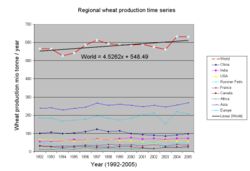
There are substantial differences in wheat farming, trading, policy, sector growth, and wheat uses in different regions of the world. In the EU and Canada for instance, there is significant addition of wheat to animal feeds, but less so in the USA.
The two biggest wheat producers are China and the EU, followed currently by India, then USA. Developed countries USA, Canada, Australia, the EU and increasingly Argentina are the major exporters with developing countries being the main importers, although both India and China are close to being self-sufficient in wheat. In the rapidly developing counties of Asia, Westernization of diets associated with increasing prosperity is leading to growth in per capita demand for wheat at the expense of the other food staples.
In the past, there has been significant governmental intervention in wheat markets, such as price supports in the USA and farm payments in the EU. In the EU these subsidies have encouraged heavy use of fertilizers inputs with resulting high crop yields. In Australia and Argentina direct government subsidies are much lower.[13]
Agronomy[edit]
Crop development[edit]
Wheat normally needs between 110 and 130 days between planting and harvest, depending upon climate, seed type, and soil conditions (winter wheat lies dormant during a winter freeze). Optimal crop management requires that the farmer have a detailed understanding of each stage of development in the growing plants. In particular, spring fertilizers, herbicides, fungicides, growth regulators are typically applied only at specific stages of plant development. For example, it is currently recommended that the second application of nitrogen is best done when the ear (not visible at this stage) is about 1 cm in size (Z31 on Zadoks scale). Knowledge of stages is also important to identify periods of higher risk from the climate. For example, pollen formation from the mother cell, and the stages between anthesis and maturity are susceptible to high temperatures, and this adverse effect is made worse by water stress.[14] Farmers also benefit from knowing when the 'flag leaf' (last leaf) appears, as this leaf represents about 75% of photosynthesis reactions during the grain filling period, and so should be preserved from disease or insect attacks to ensure a good yield.
Several systems exist to identify crop stages, with the Feekes and Zadoks scales being the most widely used. Each scale is a standard system which describes successive stages reached by the crop during the agricultural season.
Wheat stages[edit]
Wheat at the anthesis stage; wheat spikelet with the three anthers sticking out.
Diseases[edit]
There are many wheat diseases, mainly caused by fungi, bacteria and viruses.[15] Plant breeding to develop new disease-resistant varieties, and sound crop management practices are important for preventing disease. Fungicides, used to prevent the significant crop losses from fungal disease, can be a significant variable cost in wheat production.
The main wheat-disease categories are:
- Seed-Borne Diseases: these include seed-borne scab, seed-borne Stagonospora (previously known as Septoria), common bunt (stinking smut), and loose smut. These are managed with fungicides.
- Leaf- and Head- Blight Diseases: Powdery mildew, leaf rust, Septoria tritici leaf blotch, Stagonospora (Septoria) nodorum leaf and glume blotch, and Fusarium head scab.
- Crown and Root Rot Diseases: Two of the more important of these are 'take-all' and Cephalosporium stripe. Both of these diseases are soil borne.
- Virus Diseases: Wheat spindle streak mosaic (yellow mosaic) and barley yellow dwarf are the two most common virus diseases. Control can be achieved by using resistant varieties.
Main article: Wheat diseases
Pests[edit]
Wheat is eaten by the larvae of some Lepidoptera species including The Flame, Rustic Shoulder-knot, Setaceous Hebrew Character and Turnip Moth. Early in the season, birds and rodents can also cause significant damage to a crop by digging up and eating newly planted seeds or young plants. They can also damage the crop late in the season by eating the grain from the mature spike. Recent post-harvest losses in cereals amount to billions of dollars per year in the USA alone, and damage to wheat by various borers, beetles and weevils is no exception. [16] Rodents can also cause major losses during storage, and in major grain growing regions, field mice numbers can sometimes build up explosively to plague proportions because of the ready availability of food.[17]
Farming systems[edit]
In the Punjab, India, and North China, irrigation has been a major contributor to increased grain output. More widely over the last 40 years, a massive increase in fertilizer use together with the increased availability of semi-dwarf varieties in developing countries, has greatly increased yields per hectare. In developing countries, use of (mainly nitrogenous) fertilizer increased 25-fold in this period. However, farming systems rely on much more than fertilizer and breeding to improve productivity. A good illustration of this is Australian wheat growing in the southern winter cropping zone, where, despite low rainfall (300 mm), wheat cropping is successful even with relatively little use of nitrogenous fertilizer. This is achieved by 'rotation cropping' (traditionally called the ley system) with leguminous pastures and, in the last decade, including a canola crop in the rotations has boosted wheat yields by a further 25% [18]. In these low rainfall areas, better use of available soil-water (and better control of soil erosion) is achieved by retaining the stubble after harvesting and by minimizing tillage.[19]
Genetics and breeding[edit]
- See also Wheat taxonomy, Plant breeding
Wheat genetics is more complicated than that of most other domesticated species. Some wheat species occur as stable polyploids, having more than two sets (the diploid number) of chromosomes. A single set of wheat chromosomes contains a huge number of DNA base pairs - 16 billion, 40 times as many as rice, and five times as many as humans!
- Einkorn wheat (T. monococcum) is diploid (AA, two complements of seven chromosomes, 2n=14)
- Tetraploid wheats have four sets of chromosomes, twice the number of chromosomes as a diploid wheat (4n=28). Most tetraploid wheats (e.g. emmer and durum wheat) are derived from wild emmer, T. dicoccoides. Wild emmer itself is the result of a hybridization between two diploid wild grasses, T. urartu (AA) and a wild goat-grass (BB), never identified among now surviving wild grasses, but whose closest living relative is Aegilops speltoides. The hybridization that formed wild emmer (AABB) happened long before domestication, and was driven by natural selection.
- Hexaploid wheats evolved in farmers' fields. Either emmer or durum wheat hybridized with yet another wild diploid grass (Aegilops tauschii, DD) to make the hexaploid (six chromosome complements, AABBDD, 6n=42) wheats, spelt and bread wheat. These have three sets of paired chromosomes, three times as many as in diploid wheat.
The presence of certain versions of wheat genes has been important for crop yields. Apart from mutant versions of genes selected in antiquity during domestication, there has been more recent deliberate selection of alleles that affect growth characteristics. Genes for the 'dwarfing' trait, first used by Japanese wheat breeders to produce short-stalked wheat, have had a huge effect on wheat yields world-wide, and were major factors in the success of the Green revolution in Mexico and Asia. Dwarfing genes enable the carbon that is fixed in the plant during photosynthesis to be diverted towards seed production, and they also help prevent the problem of lodging. 'Lodging' occurs when a ear stalk falls over in the wind and rots on the ground, and heavy nitrogenous fertilization of wheat makes the grass grow taller and become more susceptible to this problem. By 1997, 81% of the developing world's wheat acreage was planted to semi-dwarf wheats, giving both increased yields and better response to nitrogenous fertilizer.
Wild grasses in the genus Triticum and related genera, and grasses such as rye have been a source of many disease-resistance traits for cultivated wheat breeding since the 1930s.[20]
Heterosis, or hybrid vigor (as in the familiar F1 hybrids of maize), occurs in common (hexaploid) wheat, but it is difficult to produce seed of hybrid cultivars on a commercial scale (as is done with maize) because wheat flowers are complete and normally self-pollinate. Commercial hybrid wheat seed has been produced using chemical hybridizing agents; these chemicals selectively interfere with pollen development, or naturally occurring cytoplasmic male sterility systems. Hybrid wheat has been a limited commercial success in Europe (particularly France), the USA and South Africa.[21] F1 hybrid wheat cultivars should not be confused with the standard method of breeding inbred wheat cultivars by crossing two lines using hand emasculation, then selfing or inbreeding the progeny many (ten or more) generations before release selections are identified to be released as a variety or cultivar.
Synthetic hexaploids made by crossing the wild goatgrass wheat ancestor Aegilops tauschii and various durum wheats are now being deployed, and these increase the genetic diversity of cultivated wheats.
Stomata (or leaf pores) are involved in both uptake of carbon dioxide gas from the atmosphere and water vapor losses from the leaf due to water transpiration. Basic physiological investation of these gas exchange processes has yielded valuable carbon isotope based methods that are used for breeding wheat varieties with improved water-use efficiency. These varieties can improve crop productivity in rain-fed dry-land wheat farms.[22]
References[edit]
- ↑ Belderok B et al. (2000) Bread-Making Quality of Wheat Springer p 3 ISBN 0-7923-6383-3
- Abengoa And Dyadic Sign Ethanol R&D Agreement Posted Oct 31st, 2006
- Cauvain SP, Cauvain P (2003) Bread Making CRC Press p 540 ISBN 1-85573-553-9
- Bergen R 'American wheat beers' In Brewing Techniques
- FAOSTAT Agricultural statistics 2005 data values
- ↑ Lev-Yadun S et al. (2000) The cradle of agriculture Science 288471:1602-3 PMID 10858140
- ↑ Heun MR et al (1997) Site of Einkorn Wheat Domestication Identified by DNA Fingerprinting Science 278:1312-4 DOI: 10.1126/science.278.5341.1312
- ↑ Özkan H et al. (2002) AFLP analysis of a collection of tetraploid wheats indicates the origin of emmer and hard wheat domestication in southeast Turkey Molecular Biology and Evolution19:1797-1801 (2002) PMID 12270906
- ↑ Tanno, K Willcox, G (2006) How fast was wild wheat domesticated? Science 311 1886 DOI 10.1126/science.1124635 PMID 16574859
- ↑ Diamond J (1997) Guns, Germs and Steel, A short history of everybody for the last 13,000 years. Viking UK Random House ISBN 0-09-930278-0
- ↑ Direct quotation: Grundas ST : Chapter: Wheat: The Crop, in Encyclopedia of Food Sciences and Nutrition p6130, 2003; Elsevier Science Ltd
- ↑ See Chapter 1, Slafer GA, Satorre EH (1999) Wheat: Ecology and Physiology of Yield Determination Haworth Press Technology & Industrial ISBN 1560228741.
- ↑ Other names besides Emmer are amidonnier (France) and Emmertarwe (Dutch) as well as the erroneous use of Einkorn occasionally found in Germany.
- ↑ Confarreatio, the name for an ancient Roman wedding, is derived from the libum farreum, a simple emmer cake that was offered to Iuppiter farreus during the ceremony.
- ↑ Ali MB (2002) Characteristics and production costs of US wheat farms (SB-974-5 ERS, USDA.)
- ↑ CIMMYT World wheat facts and trends 1998-9.
- ↑ CIMMYT World Wheat Overview and Outlook 2000-2001
- ↑ Slafer GA, Satorre EH (1999) Wheat: Ecology and Physiology of Yield Determination Haworth Press Technology & Industrial ISBN 1560228741. pp 322-3
- Saini HS et al. (1984) Effect of heat stress during floral development on pollen tube growth and ovary anatomy in wheat (Triticum aestivum L.) Australian Journal of Plant Physiology 10:137-144 doi:10.1071/PP9830137
- ↑ Crop Disease Management Bulletin 631-98. Wheat Diseases
- ↑ Biological Control of Stored-Product Pests. Biological Control News Volume II, Number 10 October 1995
- ↑ CSIRO Rodent Management Research Focus: Mice plagues
- ↑ Swaminathan MS (2004) Stocktake on cropping and crop science for a diverse planet
- ↑ Umbers, Alan (2006, Grains Council of Australia Limited) Grains Industry trends in Production - Results from Today’s Farming Practices
- ↑ Hoisington D et al. (1999) Plant genetic resources: What can they contribute toward increased crop productivity? Proc Natl Acad Sci USA 96:5937-43 PMID 10339521
- ↑ Basra, AS (1999) Heterosis and Hybrid Seed Production in Agronomic Crops Haworth Press pp 81-82 ISBN 1-56022-876-8
- ↑ Drysdale wheat bred for dry conditions
- Huge potential for water-efficient wheat
- Condon AG et al.(1990) Genotypic variation in carbon isotope discrimination and transpiration efficiency in wheat. Leaf gas exchange and whole plant studies Australian Journal of Plant Physiology 17: 9 - 22 doi:10.1071/PP9900009
 KSF
KSF